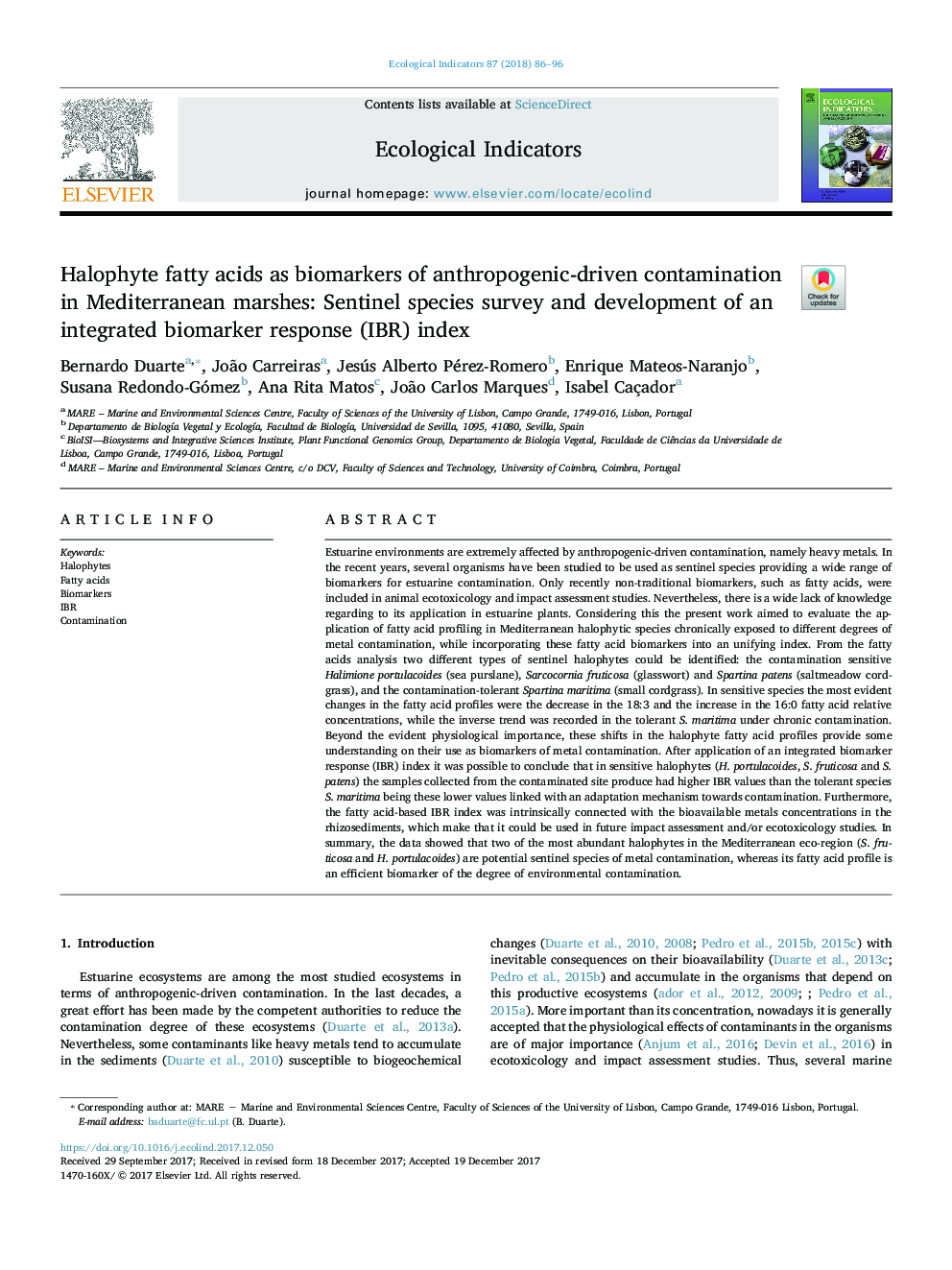| کد مقاله | کد نشریه | سال انتشار | مقاله انگلیسی | نسخه تمام متن |
|---|---|---|---|---|
| 8845572 | 1617115 | 2018 | 11 صفحه PDF | دانلود رایگان |
عنوان انگلیسی مقاله ISI
Halophyte fatty acids as biomarkers of anthropogenic-driven contamination in Mediterranean marshes: Sentinel species survey and development of an integrated biomarker response (IBR) index
دانلود مقاله + سفارش ترجمه
دانلود مقاله ISI انگلیسی
رایگان برای ایرانیان
کلمات کلیدی
موضوعات مرتبط
علوم زیستی و بیوفناوری
علوم کشاورزی و بیولوژیک
بوم شناسی، تکامل، رفتار و سامانه شناسی
پیش نمایش صفحه اول مقاله

چکیده انگلیسی
Estuarine environments are extremely affected by anthropogenic-driven contamination, namely heavy metals. In the recent years, several organisms have been studied to be used as sentinel species providing a wide range of biomarkers for estuarine contamination. Only recently non-traditional biomarkers, such as fatty acids, were included in animal ecotoxicology and impact assessment studies. Nevertheless, there is a wide lack of knowledge regarding to its application in estuarine plants. Considering this the present work aimed to evaluate the application of fatty acid profiling in Mediterranean halophytic species chronically exposed to different degrees of metal contamination, while incorporating these fatty acid biomarkers into an unifying index. From the fatty acids analysis two different types of sentinel halophytes could be identified: the contamination sensitive Halimione portulacoides (sea purslane), Sarcocornia fruticosa (glasswort) and Spartina patens (saltmeadow cordgrass), and the contamination-tolerant Spartina maritima (small cordgrass). In sensitive species the most evident changes in the fatty acid profiles were the decrease in the 18:3 and the increase in the 16:0 fatty acid relative concentrations, while the inverse trend was recorded in the tolerant S. maritima under chronic contamination. Beyond the evident physiological importance, these shifts in the halophyte fatty acid profiles provide some understanding on their use as biomarkers of metal contamination. After application of an integrated biomarker response (IBR) index it was possible to conclude that in sensitive halophytes (H. portulacoides, S. fruticosa and S. patens) the samples collected from the contaminated site produce had higher IBR values than the tolerant species S. maritima being these lower values linked with an adaptation mechanism towards contamination. Furthermore, the fatty acid-based IBR index was intrinsically connected with the bioavailable metals concentrations in the rhizosediments, which make that it could be used in future impact assessment and/or ecotoxicology studies. In summary, the data showed that two of the most abundant halophytes in the Mediterranean eco-region (S. fruticosa and H. portulacoides) are potential sentinel species of metal contamination, whereas its fatty acid profile is an efficient biomarker of the degree of environmental contamination.
ناشر
Database: Elsevier - ScienceDirect (ساینس دایرکت)
Journal: Ecological Indicators - Volume 87, April 2018, Pages 86-96
Journal: Ecological Indicators - Volume 87, April 2018, Pages 86-96
نویسندگان
Bernardo Duarte, João Carreiras, Jesús Alberto Pérez-Romero, Enrique Mateos-Naranjo, Susana Redondo-Gómez, Ana Rita Matos, João Carlos Marques, Isabel Caçador,